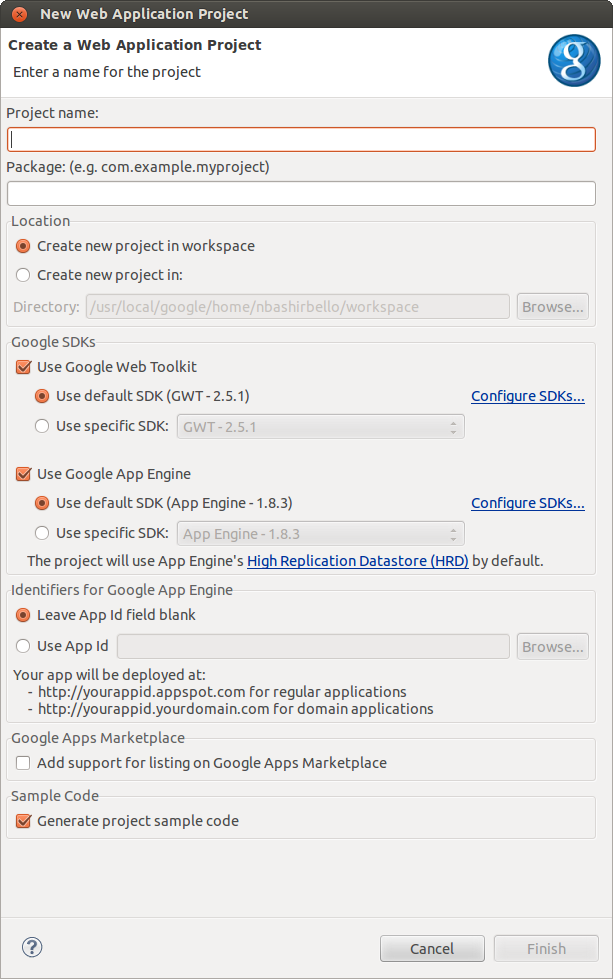Launching the New Web Application Wizard
To create a new project, click on the
 New Web Application Project
toolbar button. You can also access this wizard by selecting the
Web Application Project
item from the drop-down menu associated with the
New Web Application Project
toolbar button. You can also access this wizard by selecting the
Web Application Project
item from the drop-down menu associated with the
 New
toolbar button, or by selecting
File > New > Web Application Project
.
New
toolbar button, or by selecting
File > New > Web Application Project
.
Creating a Project with the New Web Application Wizard
The New Web Application Project wizard allows you to create a new web application that uses Google Web Toolkit (GWT) and/or Google App Engine:

The wizard allows you to choose a name and root package for the project. The project's name will be used when generating the names of the classes in the sample application. All of the classes will live in a subpackage of the root package.
Note: Using Java keywords as a project name (e.g. "New" and "Class") will result in various build errors. Avoid these where possible.
In the Google SDKs group box, you can choose which SDKs that you'd like to use in your Web Application. See Using SDKs for more details.
In the Identifiers for Google App Engine group box, you can choose to specify an app id or choose to leave the app id field blank. See Setting App ID in New Web Application Project wizards for more details.
Click on the Finish button to create the project.
Generated Project Structure
The sample application generated by the New Web Application Wizard will have a
src/
directory for Java source files and a
war/
directory for compiled classes, server runtime libraries, static content, and configuration files.
The generated files will differ depending on whether your application is using GWT, App Engine, or both. The sections below highlight the differences between the generated sample for a project named
MyTestProject
with a root package of
com.mytestproject
.
If you make a mistake and delete some of the essential resources in the
war
directory, don't worry! You can easily
fix these problems
.
GWT
These are the files that are generated for the GWT sample:
MyTestProject
src/
com/
mytestproject/
MyTestProject.gwt.xml
client/
GreetingService.java
GreetingServiceAsync.java
MyTestProject.java
server/
GreetingServiceImpl.java
war/
MyTestProject.css
MyTestProject.html
WEB-INF/
web.xml
classes/
lib/
...GWT JARs...
The GWT sample application consists of a simple user interface with a single button. When you press the button, a Remote Procedure Call is performed to get the current time on the server. The results of the call are then displayed in the interface. See GWT's documentation for more information about the project's contents.
App Engine
These are the files that are generated for the App Engine sample:
MyTestProject
src/
log4j.properties
META-INF/
jdoconfig.xml
com/
mytestproject/
MyTestProjectServlet.java
war/
index.html
WEB-INF/
appengine-web.xml
web.xml
logging.properties
classes/
lib/
...App Engine JARs...
The App Engine sample application consists of a servlet which prints "Hello, World!". The application also has some configuration files for deployment and logging. See App Engine's Getting Started Guide for more information about the project's structure and files.
GWT + App Engine
When using both the GWT and App Engine SDKs, the following sample application is generated:
MyTestProject
src/
log4j.properties
META-INF/
jdoconfig.xml
com/
mytestproject/
MyTestProject.gwt.xml
client/
GreetingService.java
GreetingServiceAsync.java
MyTestProject.java
server/
GreetingServiceImpl.java
war/
MyTestProject.css
MyTestProject.html
WEB-INF/
appengine-web.xml
web.xml
logging.properties
classes/
lib/
...App Engine JARs...
...GWT JARs...
The GWT + App Engine sample application is similar in functionality to the GWT sample application. The main difference is that the server component is meant to run on App Engine, so the App Engine configuration files are generated as well.
